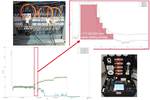Airbus forecasts $45 billion commercial aircraft services market value for U.S. by 2042
Global Services Forecast suggests a 45% increase driven by a rise in annual air traffic, fleet growth and more digitally enabled and connected aircraft.
Source | UnSplash/Ruth Enyedi
North America’s commercial aircraft services market will grow to $45 billion from $31 billion today (a 45% increase) by 2042 according to Airbus’ (Toulouse, France) latest Global Services Forecast (GSF).
North America was reported to be the first and one of the strongest regions to bounce back in the post-pandemic period. Accordingly, Airbus says that 2023 proved that more people want to fly domestically and internationally, and that passenger traffic growth will continue at a steady compound annual growth rate (CAGR) of 2.1% in the region.
Driven by the rise in annual air traffic, fleet growth and the requirement for more digitally enabled and connected aircraft, the growth in demand for services will be reflected in solutions implemented across all phases of the aircraft from delivery to end-of-life including fleet maintenance, aircraft modernization and training.
Airbus forecasts the maintenance market to grow from $25.9 billion to $37.8 billion (+2% CAGR over the next 20 years) in the region. Of this amount, passenger-to-freighter conversion and used serviceable material will be worth a cumulative estimated market value of $17 billion over the next 20 years, which will help address aircraft retirement in a sustainable way.
Meanwhile the market for enhancements and modernization is set to register the largest average annual growth (+4.1%) across the categories between 2023 and 2042, from $1.9 billion to $4.1 billion. This is driven by cabin and system upgrades, which will be in particularly high demand until 2030 as part of fleet and air traffic infrastructure modernization. Aircraft connectivity is another strong driver: Currently close to 60% of the North American fleet is connected. By 2042, 90% of the fleet will be connected in real time for better communication with airline operations on the ground, in flight and for maintenance, as well as enhancing the passenger experience.
In addition, the market for training and operations is expected to increase from $2.5 billion in 2023 to $3 billion in 2042 (+0.8%), with a plateau period following 3 years of sharp growth as the industry recovered from employee loss during the pandemic. Airbus anticipates a need for 366,000 new skilled professionals in North America over the next 20 years, comprising 104,000 new pilots, 120,000 new technicians and 142,000 new cabin crew members.
“North America is a region of choice when we think about aftermarket services, with many opportunities for additional efficiency, simplification and sustainable operations,” says Dominik Wacht, vice president – customer services, Airbus North America. “Airbus will continue to play an important role in supporting airlines and the aviation industry at large in responding to those opportunities.”
Related Content
-
Carbon fiber in pressure vessels for hydrogen
The emerging H2 economy drives tank development for aircraft, ships and gas transport.
-
Materials & Processes: Composites fibers and resins
Compared to legacy materials like steel, aluminum, iron and titanium, composites are still coming of age, and only just now are being better understood by design and manufacturing engineers. However, composites’ physical properties — combined with unbeatable light weight — make them undeniably attractive.
-
Novel dry tape for liquid molded composites
MTorres seeks to enable next-gen aircraft and open new markets for composites with low-cost, high-permeability tapes and versatile, high-speed production lines.

















